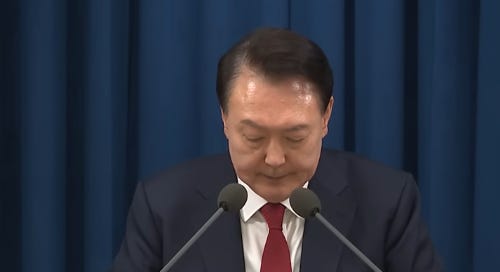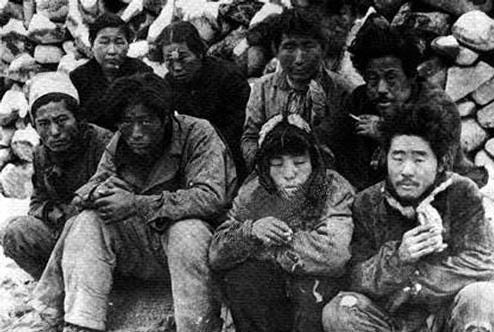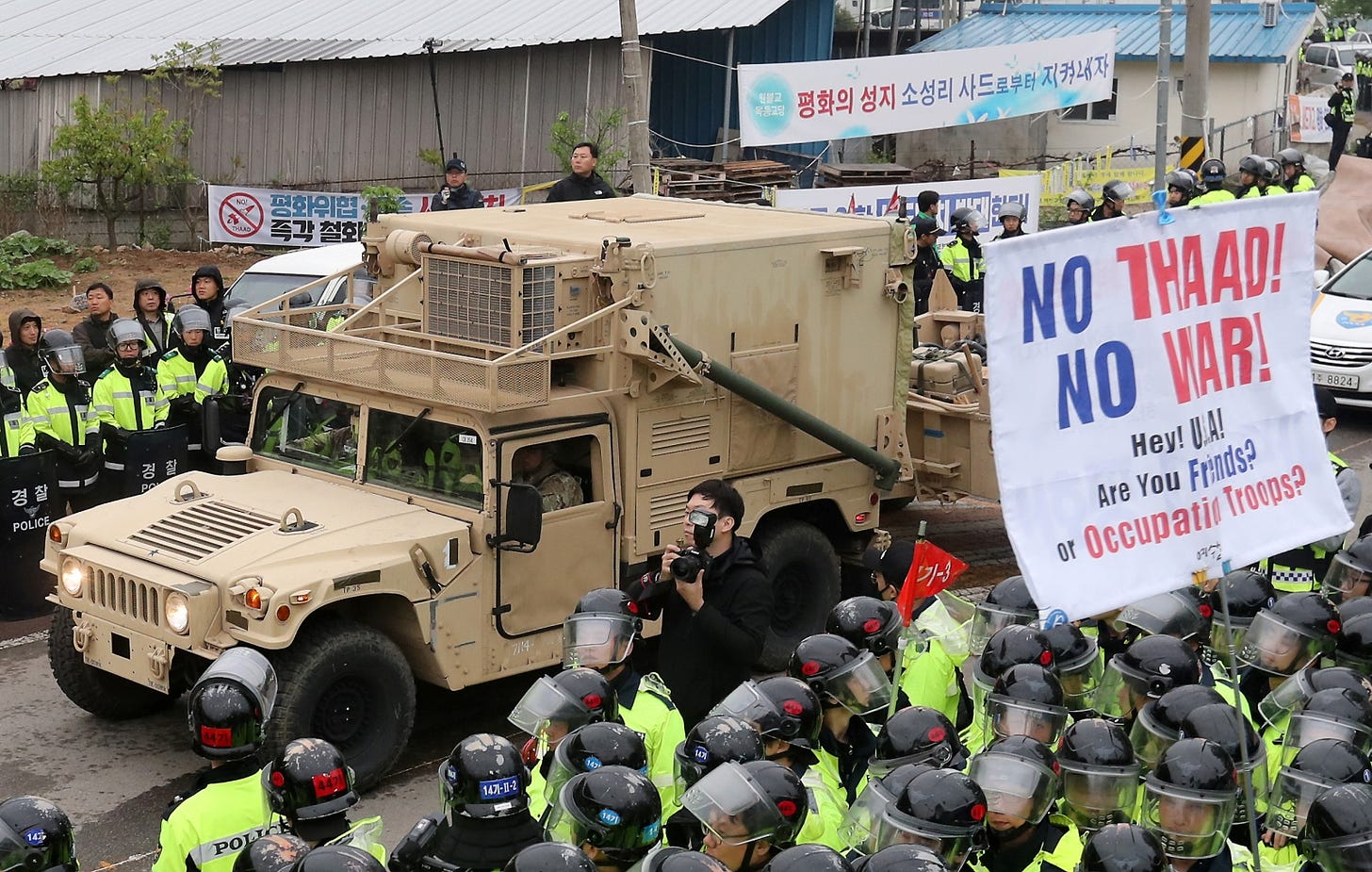The Madman of Seoul and the Outside World Part 1/2
Meet the new colonial overlord, same as the old one
This piece was released on 2 April 2025, ahead of President Yoon’s verdict for his impeachment trial.
This is Part 1 of a 2 part series on the South Korean Crisis. For part 2:
President Yoon Sook Yeol of the Republic of Korea did not have a very good year in 2024. From rejection by the voters in a parliamentary election, to failed attempts at provocation of the DPRK that precipitated a failed self-coup, and capped off with a successful vote of impeachment, pretty much everything that could go wrong did go wrong. The ROK does not exist in a vacuum though. What happens there is at least partially caused by and will impact developments in the wider world, particularly on the China question. The ROK is a crucial US vassal in East Asia, and substantial portion of Yoon’s problems come from the fact that he has been even more of a lapdog of Uncle Sam than other presidents of the country. Washington for its part has been lauding this bumbling reactionary buffoon ever since he took office and using its considerable influence to support his political efforts. To understand why, we must understand the historical development of Korea, and the current political context of the ROK.
Historically, Korea fell within the Chinese sphere of influence thanks to its close proximity to its much larger neighbor. In the 1500s, Korean nationalist hero Admiral Yi of the Joseon Kingdom fought off a Japanese invasion with the assistance of the forces of Ming China. In 1895, the ailing Qing Empire was defeated by the rising Japanese empire and was forced to surrender the Joseon Kingdom to the Japanese sphere of influence and the Chinese province of Taiwan to Japan for annexation. Within a few years even nominal Korean independence was removed by Japanese annexation. Nearly 5 decades of colonization ensued, with suppression of Korean culture and national sentiment combined brutal economic and even sexual exploitation(“comfort women”) of Korea was undertaken. China became a safe haven for Korean nationalists throughout much of this time, with a Korean govt in exile being headquartered in Shanghai, and Korean communists led by future North Korean leader Kim Il Sung being prominent in the anti-Japanese struggle in Northern China.
Following the defeat and surrender of Japan in World War 2, Koreans rose up and proclaimed the People’s Republic of Korea, which promised land reform, economic development, and punishment of collaborators. Korea was temporarily divided at the 38th parallel at US request, with Soviet troops marching in to the North from recently liberated Northern China, while US forces held on to the South. Koreans in both the North and South, regardless of ideology, regarded the division as purely temporary. In the North, the Soviet Union did not suppress the conduct of the PRK government, and Kim Il Sung returned as a nationalist war hero and quickly took over as leader in the North while the Soviet Union withdrew its troop presence in 1948. In the South, the US brutally suppressed the PRK in favor of a government made up primarily of previously pro-Japan collaborators and led by pro-western Korean independence lobbyist Syngman Rhee. Rhee’s govt proved both unpopular and extremely violent, as anti-Rhee protests and uprisings across southern Korea were drowned in blood by pro Rhee gangs and troops backed by the US, and Rhee sent repeated raids north of the 38th parallel. By the summer of 1950, the govt in Pyongyang had had enough and sent forces south to unify the country under its rule. The DPRK’s launch of their reunification war also had the effect of freezing the Chinese Civil War, as US naval forces moved to protect Chiang’s nationalist rump on Taiwan from an impending PLA attack. Following the initial near complete collapse of the Rhee regime, a massive US invasion force salvaged the Western position and pushed into the North. After warnings from Beijing went unheeded, troops of the People’s Volunteer Army marched in to Korea and pushed the US-led forces back to the 38th parallel. The war then stalemated for several years. Throughout this entire conflict, US forces behaved in a criminal and reprehensible manner, massacring hundreds of thousands of civilians on the ground throughout the entire Korean peninsula and conducting a genocidal bombing campaign of northern Korea that killed 20% of its population and destroyed basically every standing structure there. In 1953, the combat in the Korean War ended in an armistice between the two sides, but no formal peace treaty was signed so the two sides remain formally at war to this day.[1]
Following the cessation of hostilities, both sides of the Korean peninsula settled into an uneasy peace and began to reconstruct their shattered societies. The DPRK was successfully rebuilt with substantial initial assistance from the socialist bloc, while maintaining substantial independence from both socialist superpowers, the PRC and the USSR. The ROK undertook reconstruction with US assistance and leadership, with the South Korean rebuilding program being the world’s largest multilateral development project at the time. Despite this enormous amount of outside aid, the ROK achieved significantly poorer results, while the country was ruled by a succession of unpopular military autocrats backed by the US. The US ended up dragooning in the ROK military as essentially mercenaries in the Vietnam War, with the US supplying enormous sums of development aid and outright cash transfers to allow the US to substitute at least some Korean boots on the ground for US ones. Throughout this time, the US stationed thousands of troops in South Korea, while maintaining even peacetime command over ROK forces, which would not end until 1994 (wartime command remains in the hands of the US). In 1978, military autocrat Chun Doo-Hwan came to power, using the army and martial law to suppress a pro-democracy uprising in Gwangju with the support of then US president Carter. (Chun’s actions served as model for Yoon’s coup attempt) During the 1980s, the ROK economy grew rapidly, allowing it to finally surpass that of the DPRK. As the Cold War drew to a close in the late 1980s, the US saw no further need to for outright military autocrats in South Korea and allowed political liberalization in 1987. In 1989-1991, the collapse of the Soviet-led socialist camp led to a substantial economic downturn in the DPRK, conditions which then worsened through the 90s. Throughout this time, the US pursued a policy of regime change against the govt in Pyongyang, aiming to collapse the economy and cause an uprising. The DPRK nearly did collapse amidst severe economic crisis and famine thanks these factors, which was further worsened by natural disasters. As a result, the DPRK began pursuing a policy of self-reliance, and also began developing a nuclear program. The program was temporarily halted in the late 1990s following international negotiations relating to sanctions relief, but the program was resumed in the 2000s following increased hostility from the US and the breaking off of negotiations. In 2006, the DPRK tested its first nuclear weapon.[2]
In the past few years, the Korean peninsula has been of increasing importance geopolitically. As the US continues to prepare for war with China, the US bases in South Korea have become even more important than they were, with special importance for stationed heavy equipment like THAAD (Terminal High Altitude Area Defense), a major US missile defense system stationed in the ROK.[3] The ROK military itself remains an important US asset to be used essentially however the US sees fit thanks to the ROK-US Combined Forces Command.[4] However, major impediments have stood in the way of using South Korea. Japan is the main US vassal in East Asia, with US Pacific headquarters operations in Yokosuka and the largest base in the region on Okinawa.[5] For various historical and more current reasons, Japanese-South Korean relations have remained somewhat frosty, and their previous refusal to joint anti-China efforts has proven an issue for Washington.[6] The South Korean-US security treaty does not explicitly allow US forces to use the country for combat operations in the event that the ROK itself is not attacked, which means that by the letter of the law South Korea could declare neutrality and avoid participation in a war against China. A future South Korean administration might come under considerable pressure to do just that if the war does not directly impinge upon Korea. Korea also has extremely important economic links to China, with both Korean and Chinese companies conducting much business in each other. US semiconductor restrictions against China also hit the bottom line of Korean firms like Samsung.[7] These factors have previously militated against South Korea joining the anti-China crusade.
Enter Yoon Sook Yeol. The current president of South Korea, Yoon joined the right-wing People’s Power Party after a long prosecutorial career (which ironically featured his prosecution of previous scandal plagued, coup-mongering, right-wing president Park Guen Hye)[8] Yoon announced his presidential candidacy in 2021. Following a long and bitter campaign between Yoon and center-left Democratic Party candidate Lee Jae-myung, Yoon won by a plurality with a less than 1% margin, as a center-left third-party candidate had achieved a few percentage points.[9] Once Yoon assumed office in May of 2022, his administration saw an unending avalanche of problems, some of those external, many of them self-inflicted. With a deeply unpopular policy agenda, infighting within his own party, a constant flow of scandals(many of which centered around his wife), and multiple bungled crises, Yoon proved to be a disastrous president.[10] His most important legacy will be on foreign policy, and on that subject he has not deviated from his mold of unpopular reactionary initiatives of questionable soundness.
[1] Abrams, A. B. Immovable object: North Korea’s 70 years at war with American Power. Atlanta, GA: Clarity Press, 2020.
[2] Abrams, A. B. Immovable object: North Korea’s 70 years at war with American Power. Atlanta, GA: Clarity Press, 2020.
[3] Elich, Gregory. “The Fight over THAAD in Korea.” Korea Policy Institute, May 1, 2024. https://www.kpolicy.org/post/the-fight-over-thaad-in-korea.
[4] Liem, Ramsay. “South Korea, Straying off the Leash?” CounterPunch.org, February 9, 2018. https://www.counterpunch.org/2018/02/09/south-korea-straying-off-the-leash/.
[5] “US Military Bases in Japan: 23 US Bases.” Military Bases, March 7, 2018. https://militarybases.com/overseas/japan/.
[6] Inagaki, Kana, and Demetri Sevastopulo. “US and Japan Plan Biggest Upgrade to Security Pact in over 60 Years.” Financial Times, March 24, 2024. https://www.ft.com/content/df99994d-ec4b-4c3c-9c42-738ec9b338d0.
[7] “Korea, China Hold Economic Exchange Meeting to Discuss Enhanced Cooperation.” The Korea Times, October 18, 2024. https://www.koreatimes.co.kr/www/nation/2024/10/120_384508.html.
[8] Min-hyung, Lee. “Details of Coup Plot Come to Light.” The Korea Times, July 24, 2018. https://www.koreatimes.co.kr/www/nation/2025/01/356_252757.html.
[9] Tong-Hyung, Kim, and Kim Hyung-Jin. “Ex-Prosecutor, Foreign Policy Neophyte Wins S Korea Election.” AP News, March 10, 2022. https://apnews.com/article/business-elections-voting-campaigns-seoul-f29dd8982b18c1f7318d579b9afc83f1.
[10] “Yoon’s Approval Rating Hits New Low of 17 Pct: Gallup Poll.” MSN, November 8, 2024. https://www.msn.com/en-us/politics/government/yoon-s-approval-rating-hits-new-low-of-17-pct-gallup-poll/ar-AA1u3O4o.











Thank u 4 this very interesting and informative article